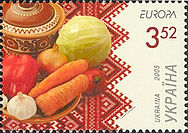Borscht
Borscht (of . Ukr and russ. Борщ , Boršč ; Pol. Barszcz ; . Dt beds Bartsch ; ro. Borş ) is a soup traditionally associated with beetroot is cooked and their preparation, especially in Eastern and Central Europe very is common. The origin of the word “borscht” or “Barszcz” is most likely the Slavic name for the herb hogweed . In the Middle Ages, the non-toxic sprouts and young leaves of this were an integral part of the soup.
description
The so-called borscht belt stretches from Poland via Galicia , Romania, Ukraine , Belarus to the Volga and Don in Russia . There and in the Ukraine, however, borscht is not necessarily served as a separate meal, but often as a soup or intermediate course for lunch or dinner. In Upstate New York , the Borscht Belt, founded by Polish-Jewish emigrants, existed analogously .
As with many Eastern European soup dishes, the long cooking time on low heat is characteristic of the preparation. Before serving, should borscht with sour cream (or sour cream ) and fresh culinary herbs (usually dill , and garlic leaves or parsley ) are refined. A (salted) garlic oil dip is often served with Ukrainian borscht, and fresh bread is always served. The East Prussian version of Beetenbartsch is served with sour cream and beef.
Regional variants
The composition varies from region to region, but meat, unfermented or fermented beetroot and white cabbage are almost always included.
Ukrainian or Russian borsch consists of unfermented beetroot , onions , white cabbage , carrots , potatoes , tomatoes and beef . Optionally, it can also contain peppers and beans . Traditionally it is said that borscht should contain enough vegetables that a wooden spoon stays in the soup pot.
Polish Barszcz, on the other hand, is made with naturally sour fermented beetroot (or beetroot juice), onions and possibly carrots. The soup is usually clear, more rarely pureed. Uszka (dumplings with mushroom, cabbage or meat filling) are often added as a filler; Krokiet (a kind of croquette) or Kołaczyk (filled yeast bun) are often served as a side dish . In Szczecin , borscht is also served as a drink with Szczecin patties .
East Prussian beetroot, on the other hand, is creamier.
There are also many other special recipes, such as fish-borscht or meadow sorrel borscht (green borscht).
Cold borscht
Cold borscht - Russian свекольник - (as a generic term for cold soups or stews is used Russian холодник, holodnik ; Polish chłodnik ; lit. šaltibarščiai ; lett. Aukstā zupa ) is also a beetroot soup, but is prepared completely differently and especially eaten in the summer. It contains neither meat nor cabbage; The basis is kefir or sour cream. The soup is not boiled, but prepared cold - the beetroot is cooked separately. There are also regional variants here.
Web links
- Why Borschtsch used to be green , Deutschlandradio Kultur
- Delicious Russia: Borschtsch, the famous beetroot soup from Russia TODAY
- Olga Martynova "Borscht", "Shchi" and Brodsky: on the Russian-Ukrainian cultural discrepancies using the example of the two national soups, "Borscht" and "Shchi". In: Neue Zürcher Zeitung , from August 16, 2010
Individual evidence
- ↑ Russianfoods.com ( Memento from February 11, 2009 in the Internet Archive )



